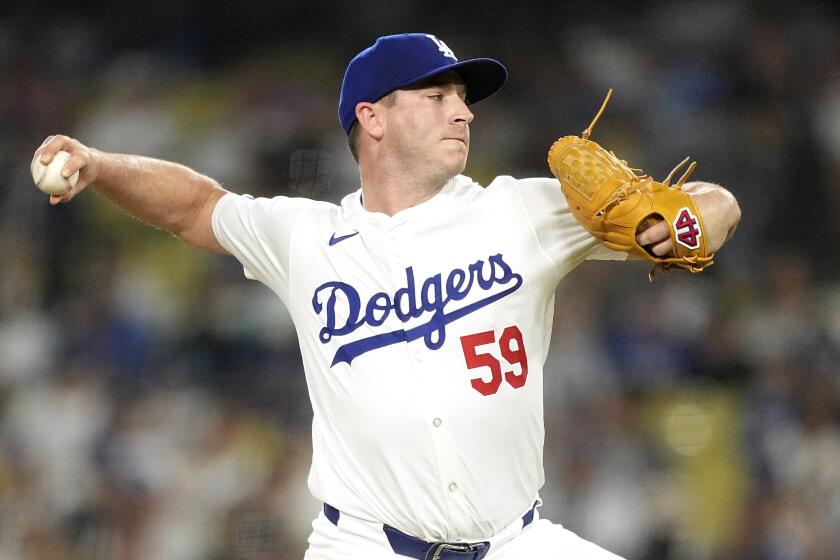Top of the Heap
When she was a year old, Dominique Moceanu’s parents had her hang by her hands from the clothesline, just to see how strong she was. In third grade, Hannes Sarkuni had become a school disciplinary problem, not because of any of the awful things we seem to hear about too often these days, but because he wasn’t being challenged enough in math. At the age of 3, Kobe Bryant spent hours dunking little basketballs through a miniature hoop, watching and imitating his father’s friends playing on TV.
Today, all three are the stuff of headlines.
Last year, at the age of 13, Moceanu became the youngest U.S. gymnastics champion and is now the best hope for an American medal in that sport in the Atlanta Summer Olympics. A few weeks ago, at 14, Sarkuni became this year’s youngest American college graduate, a double major in computer science and mathematics, from Rutgers University. And Bryant has created a sensation in the sports world at age 17 by declaring himself eligible for the National Basketball Assn. draft next month, going directly to pro ball from high school.
It appears as if the age bar is being lowered practically everywhere. “Piaget called it the American Obsession,” said Ellen Winner, a professor of psychology at Boston College and author of “Gifted Children: Myths and Realities,” a study of prodigies, just published by Basic Books. “There seems to be this obsession in America with pushing kids and breaking records.”
The general public feeling about pushing kids to the extremes seems to range from skepticism to condemnation of both parents and the kids themselves. But researchers like Winner observe the phenomenon quite differently. Their insights into so-called pushy parents, how prodigies fare as adults and how and why specific cultures seem to foster prodigiousness are sometimes at odds and often surprising.
Bryant’s announcement that he would forgo college raised hackles in sports circles. Though four other players have gone directly from high school to the NBA in the last 25 years, all were at or near 7 feet tall and all came from disadvantaged backgrounds. Bryant, whose father, Joe, played pro ball here and in Italy, is only 6 feet, 5 inches tall, and will graduate from Lower Merion High School, one of the most prestigious schools in the Philadelphia area, with a B average and 1200 on his SATs. People critical of Bryant’s move think it will be dangerous for his relatively frail, young body to go up against those several inches taller and up to 100 pounds of muscle larger.
Since his announcement, Bryant has signed a sneaker contract with Adidas for a reported $500,000 and gone to the prom with pop / R&B; singer / actress Brandy. He’s been signed by the William Morris Agency and has been projected as high as the 10th pick in the July draft, which would earn him more than $3 million based on the NBA’s rookie salary cap.
But what’s the rush here? The interest in prodigies goes far back, especially in music. Mozart was composing and presenting concerts at the age of 5. Violinist Yehudi Menuhin was the rage in the 1920s after his San Francisco debut at the age of 7. Need we mention the youthful Michael Jackson? But the interest in prodigious youth streams even further back.
“Jews have long looked for prodigiousness in firstborn sons,” said David Henry Feldman, a professor of child development at Tufts University, who has studied prodigies for 20 years. “In Tibet, they are always looking for the young spiritual master. It’s the Messiah tradition and Jesus is the most notable example. Sometimes it mutates. Menuhin, for example, was from a long line of Hasidic rabbis. In America, his family looked for early musical talent.”
One of the things about prodigies today is that they are being asked to perform to larger audiences, which, in turn, makes them available for more criticism. “Menuhin’s fame in the 1920s was actually equivalent to that of the Beatles or Rolling Stones,” Feldman said. “But today, the media is more immediate and more intense and more aspects of the prodigies’ lives come out. When they are seen on TV, for instance, they turn people off because they look freaky,” he said.
Gary Graffman, director of the prestigious Curtis Institute of Music in Philadelphia, said he is not certain that youthful musical talent is all that unusual.
“In order to be a pianist or a violinist at all, you have to start when you are 3, 4, 5,” said Graffman, 66, who himself started performing on the piano at age 7. Most of Curtis’ students are college-age, but eight are under 16 and at least one entering student next fall will be 12.
“It’s probably a question of simply developing certain muscles in certain ways very early in your life, so it becomes almost automatic or second nature,” Graffman said. “If you are not very talented, it doesn’t matter. But if you are and you haven’t (started young), then you can have the greatest conception of a piece of music that anyone has ever had, but physically you are not able to produce it.”
There are clearly cultural components of modern prodigies, which may well be self-perpetuating. Chess-playing countries like Iceland and Hungary, for instance, have many more young chess champions per capita than other cultures. Young accomplished Asian musicians abound, which observers say may be because Asian cultures often encourage playing musical instruments as a matter of course in early education.
In America, there has been in recent years a great emphasis on sporting prodigies. Some psychologists don’t like the trend.
“Competition is different in the 1990s than it was in the ‘60s and ‘70s,” said Joel Fish, director of the Center For Sport Psychology of Philadelphia. “How kids and parents define success today is different. The winning-isn’t-everything-it’s-the-only-thing idea has really caught on. Because there are so many eggs in the basket of winning, kids aren’t playing sports any more, but playing to win.”
Fish points to the plethora of organized year-round leagues in many sports in lieu of pickup and spontaneous play, which make it seem like kids are “scheduled up to their eyeballs at too early an age.” He’s worried that the example of Kobe Bryant--oddly enough, especially if he is successful--will be damaging to lesser talents.
Boston College professor Winner disagrees slightly. She said real prodigies have completely different makeups than the merely talented.
“Prodigies are not kids just being pushed by parents. They are internally driven,” Winner said. “The extremely gifted need practically no adult support. They read voraciously. They teach themselves whatever field they are in. They need some mentoring and support and encouragement, but they do not need scaffolding.”
Winner said there has been research to show that being a prodigy is no predictor of great success in later life. In fact, she said, some studies claim that dyslexia, adult depression and even learning disabilities may appear in children who are or were prodigies. Visual, musical and mathematical abilities are based in the right hemisphere in the brain while writing and reading come from the left. Thus there may be an imbalance from birth toward the right side in “spatial” prodigies, which may take away from other abilities.
“But then psychologists know more about bad things than good,” Winner said. “There is more work on retardation than there is on giftedness.”
While the common belief may be that prodigies have been pushed endlessly by parents, Tufts’ Feldman said the opposite may well be true.
“In prodigies, you find a tendency to keep a child baby-like longer, maybe because it serves the purpose of dazzling the world with their talents. You often find parents lying about their children’s age to make them appear younger,” Feldman said. “But, less sinister, these kids are often coddled--at once hurried and overprotected. There are legendary stories of great talents not being able to tie shoes or cut meat because someone always did it for them.”
That was not the case with Hannes Sarkuni. When he was in the 5th grade, said his father, Sarko, Hannes was becoming a disciplinary problem. Sarko Sarkuni had emigrated from Lebanon and didn’t want any trouble with his children in his adopted land. He sought answers and eventually found one in an algebra book. Hannes, it seemed, was merely bored with the level of math work at school. He spent hours with that book and the next and next more advanced.
Through a friend, Sarko took Hannes to the Rutgers University math department a few miles from their Cranbury, N.J., home. At 10 years old, Hannes tested into freshman calculus, becoming at that time the youngest college student in America. He graduated with honors last month in the usual four years.
“I find there is a positive side to everything,” Sarko Sarkuni said. “I questioned my pushing him in the beginning, but then I thought, ‘I don’t want to keep him from learning. Why should I deprive my son?’ ”
“Besides, in gymnastics, a kid is jumping all the time. Organs are fragile and can be hurt. It’s certainly more dangerous than intellectual things,” he said. “The more time passes, the more I see we went in a very positive direction. Of course, as a parent, you still have to say, ‘Have you done your homework?’ ”
Hannes Sarkuni plans to go on to graduate school and whether his future is earth-shattering is uncertain. Curtis Institute director Graffman did have a long performing career. It appeared to be cut short by an injury to his right arm that forced him to stop playing for a time, but he now is considered one of the greatest left-handed classical piano players, composers writing pieces expressly for him.
Graffman likes to tell a story about another well-known musical prodigy. Graffman’s father, Vladimir, was thought to be a violin wonder at age 14 at the Imperial Conservatory in St. Petersburg, Russia, when he was asked by the director to be a sort of big brother to an incoming 10-year-old student of promise by the name of Jascha Heifetz.
“I was in awe of Heifetz, so I asked my father, ‘How did Heifetz play when he was 10?’ ” said Graffman, indicating that even the greatest of prodigies must have had their flaws. “My father thought for a while and gave the only answer he knew. ‘Like Heifetz,’ ” he said. “Talent really knows no age.”
More to Read
Go beyond the scoreboard
Get the latest on L.A.'s teams in the daily Sports Report newsletter.
You may occasionally receive promotional content from the Los Angeles Times.






